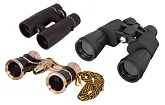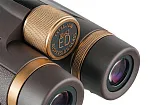How to choose and care for binoculars
CAUTION:
Never look directly at the Sun through binoculars, as that may lead to permanent retinal damage and even cause blindness.
There is a large variety of different brands and models of binoculars on the market. How do you choose the right ones?
The main thing to remember is that you need to choose binoculars that are going to be used on a regular basis. It’s a common situation when customers buy binoculars but never actually use them, so they just lie packed away and collect dust. There are many reasons why this happens; for example, you may find the binoculars too heavy or not so comfortable to use. Some people purchase binoculars that are too expensive for their budget in hopes of getting the best quality, and then hesitate using them too often for fear of damaging the binoculars.
It’s best to decide how the binoculars are going to be used before you buy them. If you need a model for everyday use, for example, to take with you during walks, then the right choice would be simple, inexpensive, lightweight binoculars with 8x magnification.
If you need an instrument for observing nature or elementary astronomical observations and you have an opportunity to observe using a tripod, then you should opt for heavier, more complex and more expensive binoculars. If you plan on long-term observations, don’t skimp on optics quality. Don’t think that “high magnification” equals “better binoculars”. The higher the magnification, the more (even the slightest) shaking of your hands affects image quality. So buying binoculars with magnification over 10x may be useless if you can’t install them on a tripod, because the image is unstable when observing from your hands. Also note that binoculars with higher magnifications have a relatively narrow field of view.
As you probably know, binoculars are marked with two numbers separated by the ‘x’ character. For example, 8x21 binoculars: the first number is the magnification (8x) and the second number is objective lens diameter in millimeters (21mm). The larger the objective lens diameter, the more light the binoculars are able to collect, and the brighter the resulting image. Desired image brightness depends on what you are going to observe: the full Moon (which is dazzlingly bright through binoculars) or birds at sunset. So as you can see, it is very important to understand the purpose for which the binoculars are to be used. It’s safe to say that 8x42 and 7x42 binoculars are all-purpose, meaning they fit many different purposes.
Quality full-size binoculars are great, but quite often what you need are compact binoculars, which you can carry in your pocket, allowing you to start observing very quickly. The best decision is to have both large quality binoculars for planned observations and inexpensive small ones to always have with you.
One more thing you should take into consideration when choosing best binoculars is the manufacturer’s warranty. You can think of the warranty as a guarantee of the binoculars’ quality. It’s safe to say that the longer the warranty is, the better.
Tips for how to care for binoculars
It doesn’t make sense to buy binoculars (which may be quite pricey) if you don’t know how to take care of them properly and keep them in good shape. Below you can find some useful tips on taking good care of your binoculars.
1. A tip for those who are just thinking about buying binoculars
If you haven’t got binoculars yet, but are thinking about buying a pair, choose the model that fits the intended use. For example, if you plan on using your new binoculars on water, make sure that they are completely waterproof. If there is a possibility that you might drop the binoculars on the ground during observations, check if their body is shockproof and generally robust, so they can survive the fall.
2. Know the limits of your binoculars
Learn what kind of challenges the binoculars can withstand. Such information is usually provided in the product description. If you are planning on observing under extreme conditions and have any doubts about the binoculars’ durability, you can contact the manufacturer or the seller to find out if the chosen binoculars are going to survive the adventure. If you know what exactly may lead to damaging the binoculars during your observations, try to elude it.
3. Always use the strap
Try to always wear the binoculars on the neck strap. Most of the falls happen when you observe something moving or some phenomenon limited in time. In such situations, you need to start observing really quickly, because the next minute the thing you want to see can disappear. So if the binoculars are not on the strap, you might accidentally drop them in a rush.
4. Use a reliable strap and check it before every observation
Always make sure that the strap is securely attached to the binoculars and doesn’t show signs of excessive wear.
5. Transport the binoculars using a pouch or a case
Store the binoculars in a pouch or a case with soft padding when they are not in use. If you leave binoculars lying around without it, there is almost 100% possibility that something bad is going to happen to them. So spend a little time to protect your binoculars.
6. Don’t leave the binoculars in direct sunlight
Don’t leave your binoculars under the direct sunlight for a long time, be it outside or in your car. The heat can damage the binoculars.
7. Clean the optics carefully and regularly
Read the manufacturer’s recommendations on cleaning the lenses (usually found in the user manual). First, try to blow dust or dirt off the lenses before cleaning them with a wipe or a brush. Then breathe on the lenses and remove visible spots with a
cleaning pen or a
cleaning cloth. Always use cleaning tools designed specifically for cleaning optics as they don’t ruin coatings and don’t leave stains on the lenses.
8. Wash the seawater off
Don’t try to clean lenses with a cloth if there is salt water on the glass as doing so may scratch the lenses. Instead, rinse the lenses with fresh water (make sure that water doesn’t get inside the binoculars if they are not waterproof).
9. Don’t try to repair binoculars on your own
No matter how insignificant the breakage seems, let professionals take care of it.
10. Extend the eyecups’ life
You can make eyecups serve you for a longer time with just a little vinyl or rubber preservative. And if the eyecups of your model can be extended, always return them to the initial position after you are done observing.
Note: don’t go by kayak or canoe with binoculars on your neck as it adds even more danger in case of turning over.
Don’t forget to take care of your binoculars after returning from hiking or traveling.
Any reproduction of the material for public publication in any information medium and in any format is prohibited. You can refer to this article with active link to eu.levenhuk.com.
The manufacturer reserves the right to make changes to the pricing, product range and specifications or discontinue products without prior notice.



